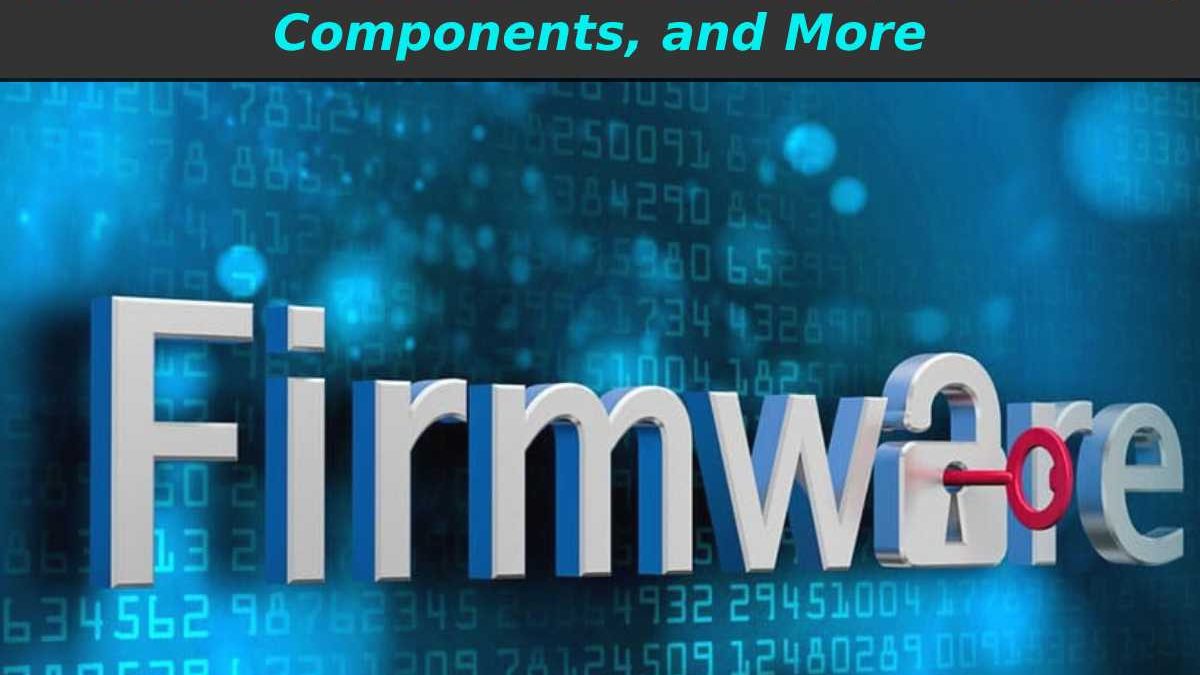Firmware or Programming- The Special Purpose firmware-or-programming Instruction Block stores non-volatile memory (ROM, EEPROM, Flash, etc.). It launches the lowest level logic that controls the electronic circuits of any device. [Firmware] is integrated into the electronics of the device.
It’s part hardware and software because it provides the logic and is available in some programming languages. Functionally, it is an intermediary (interface) between the external controls of the device and the electronics.
Since it controls the latter for the correct execution of said external orders, Firmware is located in the system ROM of various devices, such as video monitors, disk drives, printers, etc. But also in microprocessors, main memory chips, and integrated circuits.
Most Firmware stores in ROM which protects by copyright. A BIOS program is a firmware whose purpose is to activate the machine immediately after it starts up and prepares the environment for installing a complex operating system.
It also responds to external events (human buttons) and exchanges commands between various computer components. In a microprocessor, Firmware is that which receives instructions from programs and executes them in its complex circuits, issuing commands to other devices in the system.
Table of Contents
What are The Problems with The Firmware?
In a sense, the various components of the Firmware are as important as the computer’s operating system. However, different most modern operating systems, Firmware rarely has a well-designed automatic mechanism for self-updating to correct functional problems discovered after the device ships.

The BIOS is relatively easy to inform on modern PC peripherals such as video cards or modems, which rely on Firmware dynamically loaded by the device driver and can often be updated transparently via update mechanisms. In contrast, Firmware on storage devices rarely updates. In addition, the means for determining firmware versions and fixing them are not standardized.
Consequently, these devices tend to have more functional problems than other parts of a modern computer system.
What are The Firmware Components?
Component firmware is a type of software that can provide some level of control over an item. This software may provide an environment for the component’s more complex functions or act as its internal operating system.
Ultimately, the component’s Firmware is responsible for how it supposes to work or behave when networked with other devices. An example of advanced Firmware is the BIOS of our motherboards.
The map can make our computer operate because of them, but also because of it. Many features of our systems can configure differently than in their sequential arrangement. In contrast, we have more easy software, such as storage management.
Typically, this software is not modified by user and is delivered by the devices themselves. Traditionally, It stores on a non-volatile memory chip.
ROM (Read Only Memory), EPROM (Erasable Programmable Read Only Memory), or NAND flash memory can use in this semiconductor. NAND flash memory is becoming increasingly popular due to the simplicity with which the software containing within it can update.
What is The Origin of The Firmware?
Asher Opler coined the term “firmware” in a Datamation article published in 1967. It originally referred to the microcode in the writable control storage (a small specialized area of RAM Memory). It defines and implements in the computer’s instruction set. If necessary, the Firmware could reload to specialize or change the instructions that the central processing unit (CPU) could execute.
According to the original usage, It was contrasting with hardware (the processor itself) and software (the typical instructions that run on the processor). The Firmware did not fully match the processor’s machine instructions.
The lower level microcode involves in implementing the machine instructions that the CPU will execute. Firmware existed on the boundary between hardware and software, hence the term [Firmware] (“hard, fixed or reliable software”).
The term was later expanding to include any microcode in RAM or ROM. Still later, the time was extending again, gaining widespread use to refer to anything in ROM, including processor machine instructions for BIOS, boot loaders, or specialized applications.
Until the mid-1990s, the typical process for updating [Firmware] to a new version was to replace the media containing the [Firmware]. Usually, a ROM memory chip pluggers into a socket. This procedure was not long in coming, as manufacturers added it.
The new feature allows other instructions to store in the same memory, making the upgrade process much more convenient and dynamic. However, the [Firmware] upgrade process should be done very carefully as it is a vital part; any breakdown can render the equipment unusable.
For example, a power letdown in the middle of the update process will prevent the code that controls the hardware from fully loading, perhaps even the package of code responsible for updating [the Firmware].
Conclusion
Hardware and firmware developers must collaborate so that the respective components work together. The most crucial collaboration tool is documentation. Timely, accurate, and complete documentation must give great importance. This is the primary reference for engineers to develop and debug device drivers, diagnose hardware problems, and troubleshoot hardware-firmware interactions.

